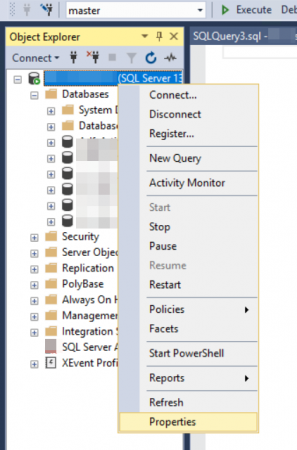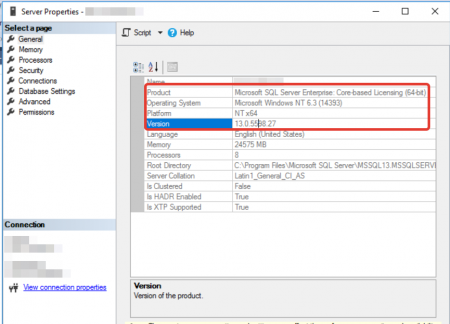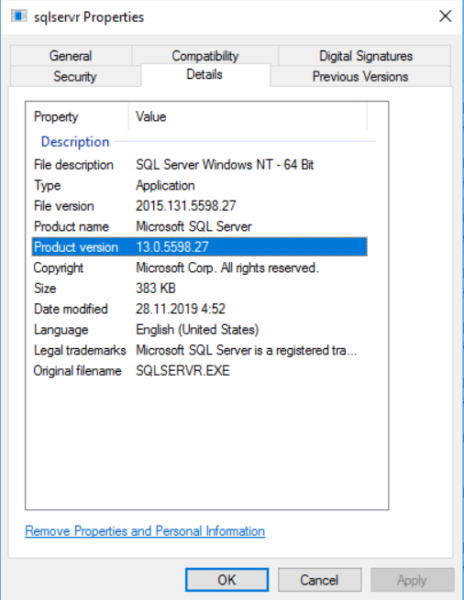REQUEST COMPLIMENTARY SQLS*PLUS LICENCE
How to specify the version and edition of SQL server
One of the tasks that one has to face during software development or DBMS administration (and, in particular, SQL Server) is determining which version of the SQL Server is installed, in which edition and which digit capacity, and which service pack is installed.
The article below describes methods of determining the installed version of SQL Server, its bit rate, version and installed service packs. Which of these methods to use depends on what tools and rights are available.
Displayed versions of SQL server and build versions have different numbering, their comparison is given in the table below:
| Server | Major Version |
| SQL 2019 | 15.0 |
| SQL 2017 | 4.0 |
| SQL 2016 | 13.0 |
| SQL 2014 | 12.0 |
| SQL 2012 | 11.0 |
| SQL 2008 R2 | 10.50 |
| SQL 2008 | 10.0 |
| SQL 2005 | 9.0 |
| SQL 2000 | 8.0 |
| SQL 7.0 | 7.0 |
| SQL 6.5 | 6.50 |
| SQL 6.0 | 6.00 |
Define the SQL server version using SSMS (SQL Server Management Studio)
To define the version of Microsoft SQL Server using SQL Server Management Studio, right-click on the instance name and select Properties.

The first tab will display the version and edition of the SQL server, as well as some other features.

Define the SQL server version using T-SQL
One of the easiest and most memorable ways to do this is to perform a simple query using a global variable of the embedded variable:
SELECT @@Version;
The result of this query will be a string with information about the server, such as a similar one:
![]()
it is necessary to obtain information about the current server parameters in a structured form and this information should be further processed, it is better to use the SERVERPROPERTY function.
The SERVERPROPERTY function returns information about server instance properties, such as version, edition, build number, and OS characteristics. Detailed information about the SERVERPROPERTY feature can be found in the documentation, at docs.microsoft.com.
A sample request and its result are shown below.
SELECT
SERVERPROPERTY('Edition') AS Edition,
SERVERPROPERTY('ProductVersion') AS ProductVersion,
SERVERPROPERTY('ProductLevel') AS ProductLevel,
SERVERPROPERTY('ProductUpdateLevel') AS ProductUpdateLevel,
SERVERPROPERTY('Collation') AS Collation,
SERVERPROPERTY('InstanceName') AS InstanceName,
SERVERPROPERTY('IsClustered') AS IsClustered;
The result of the request:

You can also specify other fields in the query if you need them.
Defining the SQL Server version using file versions
If you can view the properties of the executable file sqlservr.exe located in the folder: “C:\Program Files\Microsoft SQL Server\MSSQLXX.MSSQLSERVER\MSSQL\Binn\”.
In the properties of the file, the Details tab displays the currently installed build, from which you can determine the version and installed updates.

How To Identify Your SQL Server Version And Edition
MORE NEWS
PreambleNoSql is not a replacement for SQL databases but is a valid alternative for many situations where standard SQL is not the best approach for...
PreambleMongoDB Conditional operators specify a condition to which the value of the document field shall correspond.Comparison Query Operators $eq...
5 Database management trends impacting database administrationIn the realm of database management systems, moreover half (52%) of your competitors feel...
The data type is defined as the type of data that any column or variable can store in MS SQL Server. What is the data type? When you create any table or...
PreambleMS SQL Server is a client-server architecture. MS SQL Server process starts with the client application sending a query.SQL Server accepts,...
First the basics: what is the master/slave?One database server (“master”) responds and can do anything. A lot of other database servers store copies of all...
PreambleAtom Hopper (based on Apache Abdera) for those who may not know is an open-source project sponsored by Rackspace. Today we will figure out how to...
PreambleMongoDB recently introduced its new aggregation structure. This structure provides a simpler solution for calculating aggregated values rather...
FlexibilityOne of the most advertised features of MongoDB is its flexibility. Flexibility, however, is a double-edged sword. More flexibility means more...
PreambleSQLShell is a cross-platform command-line tool for SQL, similar to psql for PostgreSQL or MySQL command-line tool for MySQL.Why use it?If you...
PreambleWriting an application on top of the framework on top of the driver on top of the database is a bit like a game on the phone: you say “insert...
PreambleOracle Coherence is a distributed cache that is functionally comparable with Memcached. In addition to the basic function of the API cache, it...
PreambleIBM pureXML, a proprietary XML database built on a relational mechanism (designed for puns) that offers both relational ( SQL / XML ) and...
What is PostgreSQL array? In PostgreSQL we can define a column as an array of valid data types. The data type can be built-in, custom or enumerated....
PreambleIf you are a Linux sysadmin or developer, there comes a time when you need to manage an Oracle database that can work in your environment.In this...
PreambleStarting with Microsoft SQL Server 2008, by default, the group of local administrators is no longer added to SQL Server administrators during the...















